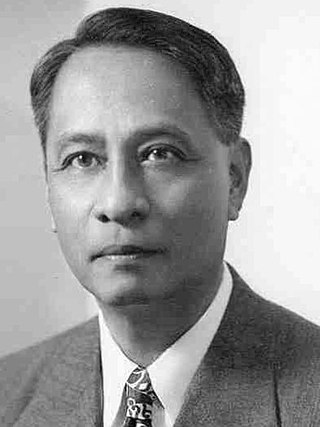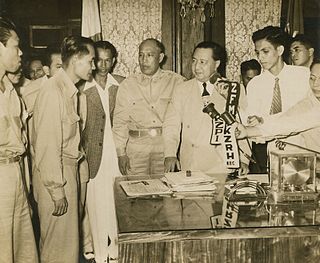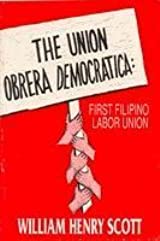Related Research Articles

Elpidio Rivera Quirino was a Filipino lawyer and politician who served as the 6th president of the Philippines from 1948 to 1953.

Manuel Acuña Roxas was a Filipino lawyer and politician who served as the fifth president of the Philippines from 1946 until his death in 1948. He served briefly as the third and last president of the Commonwealth of the Philippines from May 28, 1946, to July 4, 1946, and became the first president of the independent Third Philippine Republic after the United States ceded its sovereignty over the Philippines.

Luis Mangalus Taruc was a Filipino political figure and rebel during the agrarian unrest of the 1930s until the end of the Cold War. He was the leader of the Hukbalahap group between 1942 and 1950. His involvement with the movement came after his initiation to the problems of agrarian Filipinos when he was a student in the early 1930s. During World War II, Taruc led the Hukbalahap in guerrilla operations against the Japanese occupants of the Philippines.

The Hukbong Bayan Laban sa Hapon, better known by the acronym Hukbalahap, was a Filipino communist guerrilla movement formed by the farmers of Central Luzon. They were originally formed to fight the Japanese, but extended their fight into a rebellion against the Philippine government, known as the Hukbalahap Rebellion, in 1946. It was put down through a series of reforms and military victories by Defense Secretary, and later President, Ramon Magsaysay.

Amado Vera Hernandez, was a Filipino writer and labor leader who was known for his criticism of social injustices in the Philippines and was later imprisoned for his involvement in the communist movement. He was the central figure in a landmark legal case that took 13 years to settle.
Crisanto Abaño Evangelista was a Filipino communist politician and labor leader of the first half of the 20th century. He is credited as being one of the founders of the Partido Komunista ng Pilipinas. Evangelista was also an influential head of the Congreso Obrero de Filipinas, at the time the foremost and largest trade federation in the Philippines, having served as secretary for multiple years. He also headed the Union de Impresores de Filipinas as its Secretary-General. Prior to forming the PKP, Evangelista was a member of the Partido Obrero de Filipinas, a Filipino workers' party with increasingly radical leanings. Evangelista was eventually captured by the Japanese during the Second World War and executed.

The All-China Federation of Trade Unions (ACFTU) is the national trade union center and people's organization of the People's Republic of China. It is the largest trade union in the world with 302 million members in 1,713,000 primary trade union organizations. The ACFTU is divided into 31 regional federations and 10 national industrial unions. The ACFTU is the country's sole legally mandated trade union, with which all enterprise-level trade unions must be affiliated. There has been dispute over whether ACFTU is an independent trade union or even a trade union at all. It directs a public college, the China University of Labor Relations.
The Democratic Alliance was a leftist party in the Philippines created on July 15, 1945, primarily composed of members of the National Peasants Union of the Hukbalahap, the Committee of Labor Organizations of the Communist Party of the Philippines, the Filipino Blue Eagle Guerrillas, and other organizations. The party supported and endorsed the bid of incumbent president Sergio Osmeña and the Nacionalista Party during the 1946 presidential elections against Manuel Roxas and the Nacionalista's liberal wing due to the latter's sympathetic attitude towards Filipino collaborators of the Japanese during World War II and close affiliation with "vested-interest landlord groups".

Kilusang Mayo Uno, also known by its initials KMU is an independent labor center in the Philippines. It promotes "genuine, militant and patriotic trade unionism. The KMU was established on May 1, 1980 to fill a clear need for a workers' organization that would stand for workers' rights and against foreign domination.

People of the Philippines v. Hernandez, 99 Phil. Rep 515 (1956), was a case decided by the Philippine Supreme Court which held that the crime of rebellion under the Revised Penal Code of the Philippines is charged as a single offense, and that it cannot be made into a complex crime. While it was decided on an almost divided opinion, it nevertheless became a stable doctrine in Philippine jurisprudence

The Partido Komunista ng Pilipinas-1930 (PKP-1930), also known as the Philippine Communist Party, is a communist party in the Philippines that was established on November 7, 1930. It uses the aforementioned appellation in order to distinguish itself from its better known splinter group, the Communist Party of the Philippines.
The Central Intelligence Agency has been active in the Philippines almost since the agency's creation in the 1940s. The CIA's main headquarters for Southeast Asia is located in Manila, the capital of the Philippines. The CIA was founded in 1947 and first played a major role in the Philippines three years later. The presence of U.S. military bases in the Philippines, originally conceived through the 1947 Military Bases Agreement giving the United States authorization to utilize Clark Field and Subic Bay, made it highly accessible to the agency. During this time, the CIA ran many covert operations in the country and employed it as a base to launch actions against other countries. The agency had supply, training, and logistical centers on multiple Philippine islands. After their successful counterinsurgency against the Hukbalahap, the CIA reused this model in both Vietnam and Latin America. The CIA deployed psychological warfare in the Philippines as well as force.

The Hukbalahap Rebellion was a rebellion staged by former Hukbalahap or Hukbong Bayan Laban sa Hapon soldiers against the Philippine government. It started in 1942 during the Japanese occupation of the Philippines, continued during the presidency of Manuel Roxas, and ended in 1954 under the presidency of Ramon Magsaysay.
Guillermo Capadocia (1909-1951) was a Filipino communist politician and labour leader. He was a prominent leader of the Communist Party in the Philippines (PKP) and different labour movements. During the last one and a half years of his life he was a regional guerrilla commander of the Hukbalahap.
The Collective Labor Movement was a trade union centre in the Philippines. The CLM was founded in 1938 and consisted of 76 radical and liberal trade unions. It represented a regroupment of the leftist sectors of the Filipino trade union movement. CLM was the largest labour organization in the country in the years in the run-up to the Second World War.

The Unión Obrera Democrática Filipina was a trade union center in the Philippines. The organization was considered as the first-ever modern trade union federation in the country composed of unions from various labor industries; earlier labor groups had been more of mutual aid societies and guilds. The organization had thirty-three affiliated trade unions as of 1902. In 1903, the organization counted 150 affiliated unions, with around 20,000 members in the Manila area. At its peak, the Union Obrera Democratica had approximately 150,000 members in eight provinces of Luzon. Its members were also the very first members of the Philippine Independent Church when it was proclaimed in 1902.
Communism in the Philippines emerged in the first half of the 20th century during the American Colonial Era of the Philippines. Communist movements originated in labor unions and peasant groups. The communist movement has had multiple periods of popularity and relevance to the national affairs of the country, most notably during the Second World War and the Martial Law Era of the Philippines. Currently the communist movement is underground and considered an insurgent movement by the Armed Forces of the Philippines.

The Katipunan ng mga Anak-Pawis sa Pilipinas (KAP) was the third trade union federation in the Philippines. It was formed in 1929 after an antagonistic national convention of the Congreso Obrero de Filipinas where election results were manipulated caused Crisanto Evangelista and his faction to split from the COF. In 1930, the KAP changed its name to Partido Komunista ng Pilipinas after it initiated the formation of a "mass political party" and questions arose regarding its name.
Juan Feleo was a Filipino peasant leader and politician. He was one of the founders of one of the Philippines' leading peasant groups, the Kalipunang Pambansa ng Magbubukid sa Pilipinas and a top-ranking member of the Partido Komunista ng Pilipinas. He was also involved in the HUKBALAHAP, and his death sparked the subsequent Huk Rebellion.
Anarchism in the Philippines has its roots in the anti-colonial struggle against the Spanish Empire, becoming influential in the Philippine Revolution and the country's early trade unionist movement. After being supplanted by Marxism-Leninism as the leading revolutionary tendency during the mid-20th century, it experienced a resurgence as part of the punk subculture, following the fragmentation of the Communist Party of the Philippines.
References
- ↑ West, Lois A. (1997). Militant Labor in the Philippines. Temple University Press. p. 156. ISBN 1-56639-491-0.
- ↑ Azama, Rodney S. (April 1, 1985). "The Huks And The New People's Army: Comparing Two Postwar Filipino Insurgencies" . Retrieved December 7, 2017.
- ↑ Kerkvliet, Benedict J. (1977). The Huk Rebellion: A Study of Peasant Revolt in the Philippines . University of California Press. pp. 138. ISBN 0520031067.
congress of labor organizations philippines huk.
- ↑ Supreme Court of the Philippines (May 30, 1964). "People of the Philippines vs. Amado V. Hernandez" . Retrieved December 7, 2017.
